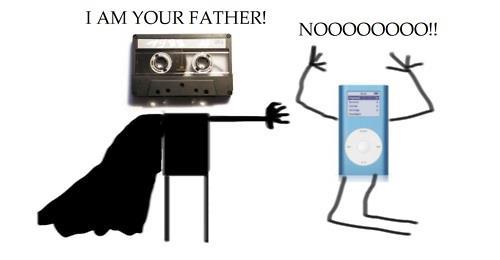The iPod line came from Apple’s “digital hub” category, when the company began creating software for the growing market of personal digital devices. Digital cameras, camcorders and organizers had well-established mainstream markets, but the company found existing digital music players “big and clunky or small and useless” with user interfaces that were “unbelievably awful,” so Apple decided to develop its own. As ordered by CEO Steve Jobs, Apple’s hardware engineering chief Jon Rubinstein assembled a team of engineers to design the iPod line, including hardware engineers Tony Fadell and Michael Dhuey, and design engineer Jonathan Ive.[5] The product was developed in less than one year and unveiled on October 23, 2001. Jobs announced it as a Mac-compatible product with a 5 GB hard drive that put “1,000 songs in your pocket.”
Apple did not develop the iPod software entirely in-house, instead using PortalPlayer‘s reference platform based on two ARM cores. The platform had rudimentary software running on a commercial microkernel embedded operating system. PortalPlayer had previously been working on an IBM-branded MP3 player with Bluetooth headphones. Apple contracted another company, Pixo, to help design and implement the user interface under the direct supervision of Steve Jobs. As development progressed, Apple continued to refine the software’s look and feel. Starting with the iPod mini, the Chicago font was replaced with Espy Sans. Later iPods switched fonts again to Podium Sans—a font similar to Apple’s corporate font, Myriad. iPods with color displays then adopted some Mac OS X themes like Aqua progress bars, and brushed metal meant to evoke a combination lock. In 2007, Apple modified the iPod interface again with the introduction of the sixth-generation iPod classic and third-generation iPod nano by changing the font to Helvetica and, in most cases, splitting the screen in half by displaying the menus on the left and album artwork, photos, or videos on the right (whichever was appropriate for the selected item).
In September 2007, during a lawsuit with patent holding company Burst.com, Apple drew attention to a patent for a similar device that was developed in 1979. Kane Kramer applied for a UK patent for his design of a “plastic music box” in 1981, which he called the IXI. He was unable to secure funding to renew the US$ 120,000 worldwide patent, so it lapsed and Kramer never profited from his idea.
The Compact Cassette, often referred to as audio cassette, cassette tape, cassette, or simply tape, is a magnetic tape sound recording format. It was designed originally for dictation, but improvements in fidelity led the Compact Cassette to supplant the Stereo 8-track cartridge and reel-to-reel tape recording in most non-professional applications. Its uses ranged from portable audio to home recording to data storage for early microcomputers. Between the early 1970s and the late 1990s, the cassette was one of the two most common formats for prerecorded music, first alongside the LP record and later the Compact Disc

